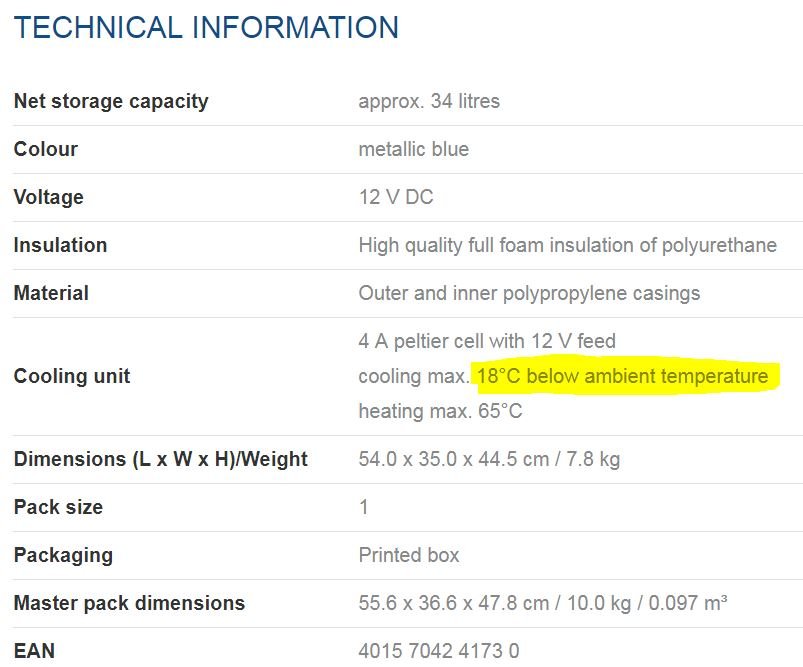You are using an out of date browser. It may not display this or other websites correctly.
You should upgrade or use an alternative browser.
You should upgrade or use an alternative browser.
DCDC charger outputs
- Thread starter Chriso1988
- Start date

Help Support Prospecting Australia:
This site may earn a commission from merchant affiliate
links, including eBay, Amazon, and others.
Take a photo and put that up see how it goes
Topical prime minister talk the talk and the run lmao :lol: :lol: :lol:
No worries mate have a good one
No worries mate have a good one
I had a durry!..and although I face assasination from my opposition party...The women's movement to beat up on their Husbands Party! ] this is the best I can do!
this is the best I can do!  your gonna be in big trouble when you come up here mate!...wifey is pissed right off ]
your gonna be in big trouble when you come up here mate!...wifey is pissed right off ] ]
] can't you two silly boys do this in daylight hours!...whoa!... :lol: :lol: there goes 10 brownies down the gurgler!..hehe
can't you two silly boys do this in daylight hours!...whoa!... :lol: :lol: there goes 10 brownies down the gurgler!..hehe
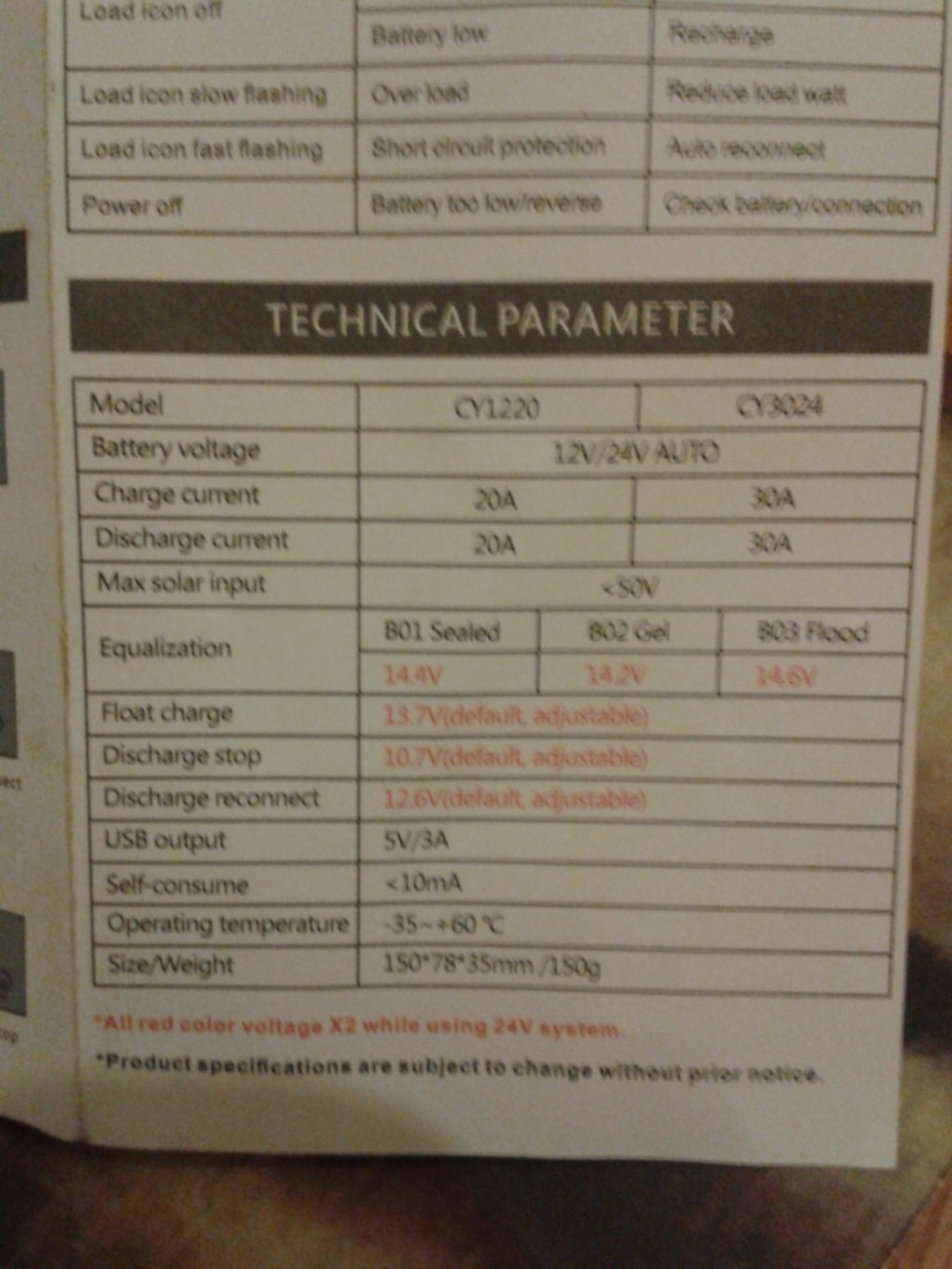 ...and this
...and this
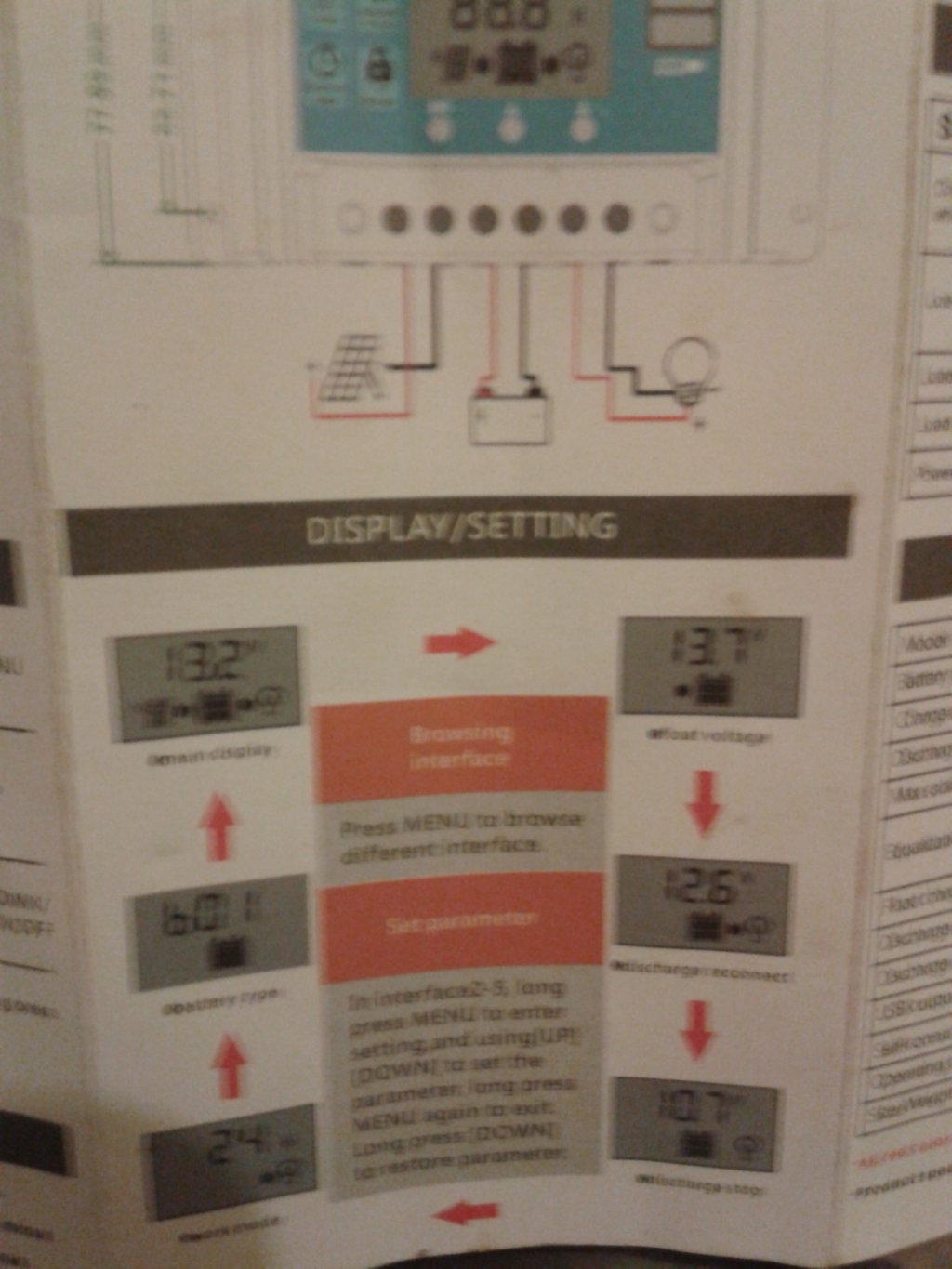 and finally this
and finally this
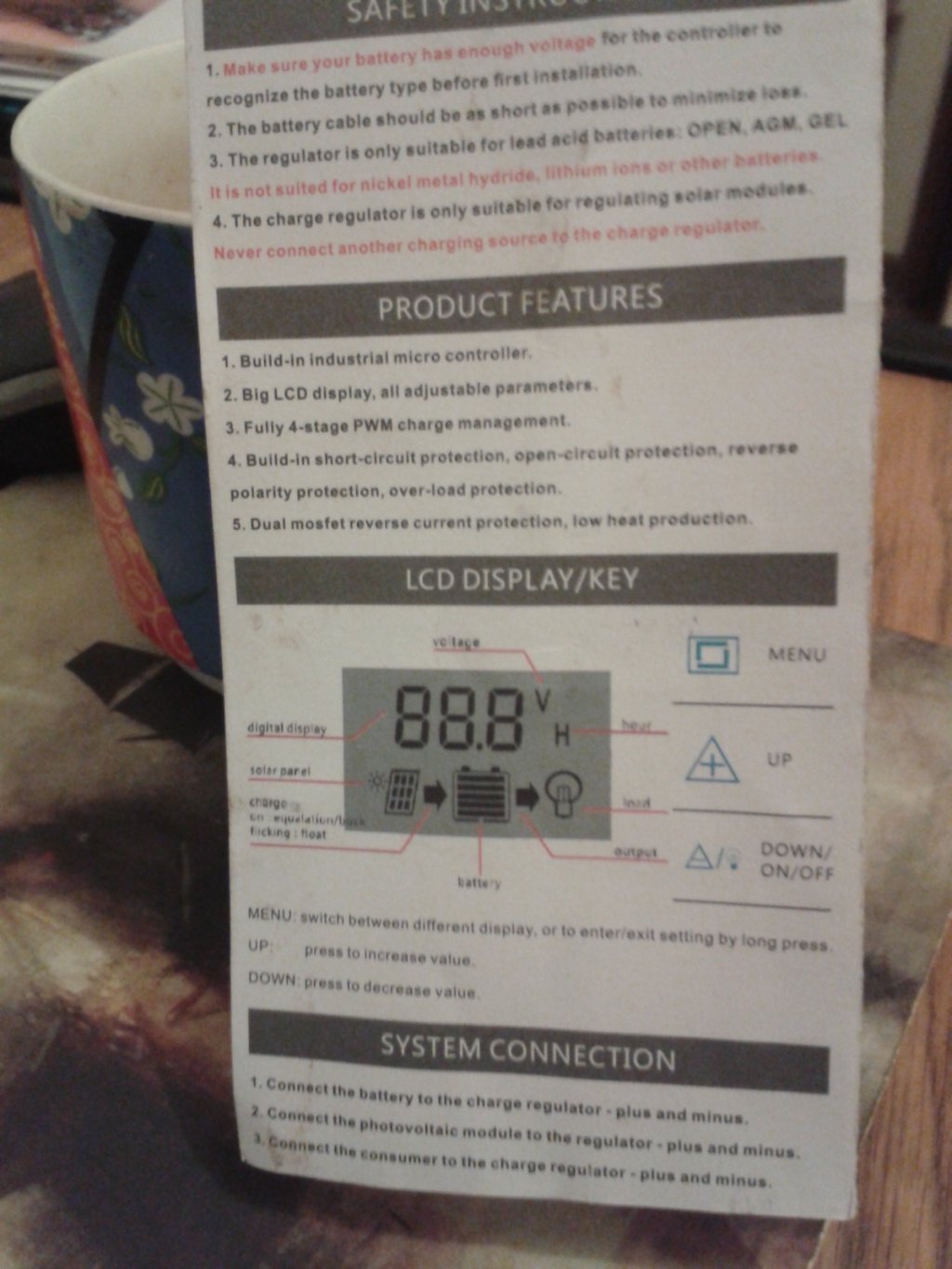 ....will be here for 10 minuto's...magic pill in progress. :Y: 8) 8)
....will be here for 10 minuto's...magic pill in progress. :Y: 8) 8)



condor22
Mike
7.62marksman said:Its a converted trailer so only runs 12v
Thanks 7
condor22
Mike
Tathradj said:What size is the panel. ?
60, 80 watts.?
As I mentioned above, given the size, less than that...
condor22
Mike
Ok, I got the model number from the pic, Googled it and downloaded the Manual.
So firstly it's a PWM controller.
2nd, not sure if it's the 20A model or 30A model, but that makes little difference to any issues.
3rd, the instructions are, for want of a better word, CRAP Seems like thy are written in Chinglish.
Seems like thy are written in Chinglish.
4th "Consumer" is LOAD - Most simple controllers have 3 sets of terminals. They consist of a + & - for each of SOLAR, BATTERY & LOAD and in the case of this controller, the instructions state in what order to connect the system up. First the BAT, then the SOLAR, then the LOAD. However, as a precaution when you connect the panel, cover it with something if in sunlight. This will help prevent the system being "shocked" with an immediate input as you terminate the wires. Also, it is best practice what whatever wires you connect BAT, SOL or LOAD, connect the Black - wire first.
As to the menu, I can't understand the Manual, as I said it's Crap. However, in most controllers, using up/down buttons you scroll through various menu levels, then you press something else whilst in that menu to adjust the settings.
More....
So firstly it's a PWM controller.
2nd, not sure if it's the 20A model or 30A model, but that makes little difference to any issues.
3rd, the instructions are, for want of a better word, CRAP
4th "Consumer" is LOAD - Most simple controllers have 3 sets of terminals. They consist of a + & - for each of SOLAR, BATTERY & LOAD and in the case of this controller, the instructions state in what order to connect the system up. First the BAT, then the SOLAR, then the LOAD. However, as a precaution when you connect the panel, cover it with something if in sunlight. This will help prevent the system being "shocked" with an immediate input as you terminate the wires. Also, it is best practice what whatever wires you connect BAT, SOL or LOAD, connect the Black - wire first.
As to the menu, I can't understand the Manual, as I said it's Crap. However, in most controllers, using up/down buttons you scroll through various menu levels, then you press something else whilst in that menu to adjust the settings.
More....
condor22
Mike
Sorry I can't say too much more about this controller, all I can suggest is that if you can't find a supplier in your local area of this particular controller that can perhaps run you through the menu, any solar installer might be able to help
I found a You Tube video on how to program it, might help
https://www.youtube.com/watch?v=zhRdRj-J-5c
From what I can see, you need to set battery type according to the chart B01 for AGM, B02 for GEL etc.
Float V should be about 13.7 or 13.8
Your load disconnect V is when the battery reaches a certain V, the load disconnects to stop further discharge, for an AGM I would set this to 12.4 to start with.
Work Mode is 24 which is daily
Discharge stop, I would set this to 12V, any lower will bugger the battery in my opinion.
Also from what I can see, setting this controller up requires a good battery to be connected, using your start battery, then disconnecting it to then connect to the Camper battery will not help, as I am fairly certain the settings are lost every time you disconnect the system.
If all you are running is a 35lt fridge and some LED lights, you will need at least a 100AH battery, where it me I would go to a 130AH which is what I use, as it's the largest AH above 100 within a similar physical size. To adequately solar charge either and to run a Fridge effectively off the grid, you should have at least 200W of solar or an alternative charging method.
I would NOT recommend using any other input source to the controller i.e. your vehicle system. It is 13.8V to 14.5V depending on make/model and a variable unknown amperage. A solar panel is nearer 20V and will have a maximum output within the controllers range.
If you get more solar panels a 20A controller will handle 200W anything more will need a bigger controller.
Finally, from what I have sourced on the net, your controller is not MPPT and one comment stated it's not even true PWM and is an Ebay cheapie, so don't expect too much, lol.
I found a You Tube video on how to program it, might help
https://www.youtube.com/watch?v=zhRdRj-J-5c
From what I can see, you need to set battery type according to the chart B01 for AGM, B02 for GEL etc.
Float V should be about 13.7 or 13.8
Your load disconnect V is when the battery reaches a certain V, the load disconnects to stop further discharge, for an AGM I would set this to 12.4 to start with.
Work Mode is 24 which is daily
Discharge stop, I would set this to 12V, any lower will bugger the battery in my opinion.
Also from what I can see, setting this controller up requires a good battery to be connected, using your start battery, then disconnecting it to then connect to the Camper battery will not help, as I am fairly certain the settings are lost every time you disconnect the system.
If all you are running is a 35lt fridge and some LED lights, you will need at least a 100AH battery, where it me I would go to a 130AH which is what I use, as it's the largest AH above 100 within a similar physical size. To adequately solar charge either and to run a Fridge effectively off the grid, you should have at least 200W of solar or an alternative charging method.
I would NOT recommend using any other input source to the controller i.e. your vehicle system. It is 13.8V to 14.5V depending on make/model and a variable unknown amperage. A solar panel is nearer 20V and will have a maximum output within the controllers range.
If you get more solar panels a 20A controller will handle 200W anything more will need a bigger controller.
Finally, from what I have sourced on the net, your controller is not MPPT and one comment stated it's not even true PWM and is an Ebay cheapie, so don't expect too much, lol.
Doug..and condor22...the solar unit, Actual face not including the frame is..960x290mm.
The 'car battery' is the battery in my Prado..7.62 has reminded me that he had his
jumper leads hooked up to the trailer battery when he was here last.
Electrical system is referring to the that which is on the trailer-van...and the Fridge is
a ' Mobicool ' T35 AC/DC TYPE. I believe it was made by Waeco! , as one of the documents
which accompanied it refers to it as being one.
Below is the clearest pic I can get of the display settings.I hope the other two are clear enough!
regards to you all...
oh and Tathra...I got a big goolie lined up to throw at you! ] It's got this big vein of yellow stuff
It's got this big vein of yellow stuff
sticking out of it!....your editing skills are...LOUSY!.....
 :Y: ]
:Y: ] LMAO..
LMAO..
BELOW:..is the best pic I can do, of the DISPLAY SETTINGS.
kindest regards to you both, !
Rossco.
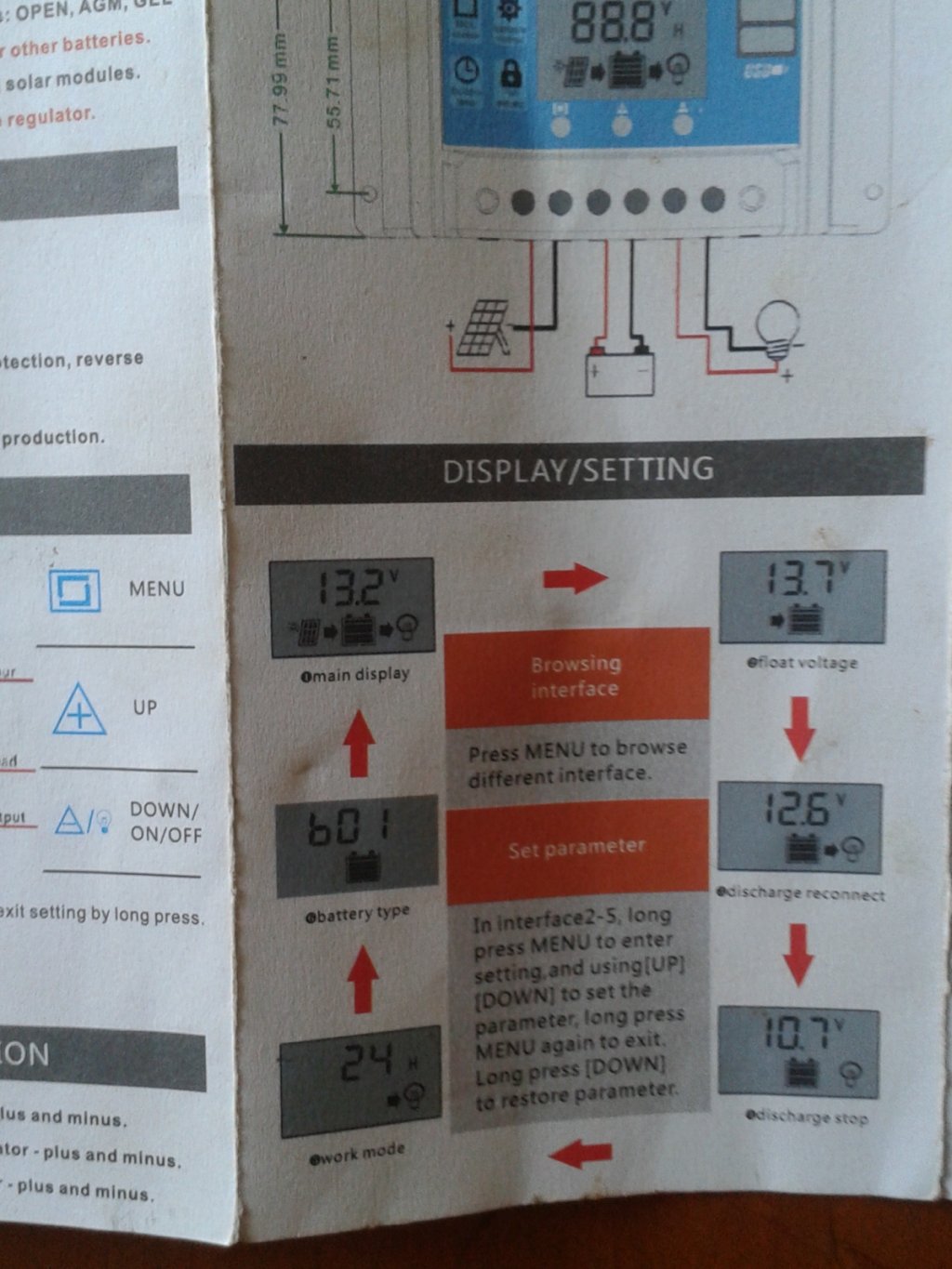
]
The 'car battery' is the battery in my Prado..7.62 has reminded me that he had his
jumper leads hooked up to the trailer battery when he was here last.
Electrical system is referring to the that which is on the trailer-van...and the Fridge is
a ' Mobicool ' T35 AC/DC TYPE. I believe it was made by Waeco! , as one of the documents
which accompanied it refers to it as being one.
Below is the clearest pic I can get of the display settings.I hope the other two are clear enough!
regards to you all...
oh and Tathra...I got a big goolie lined up to throw at you! ]
sticking out of it!....your editing skills are...LOUSY!.....
BELOW:..is the best pic I can do, of the DISPLAY SETTINGS.
kindest regards to you both, !
Rossco.

]
Without fading a few brain cells, {)
Hunt around and find a small 3 way fridge.
One that will run on 12 volts while you are heading to your favorite spot.
When you get there, change to LPG.
Or, When you pull up at a Caravan park, 240 is the go.

.
What i see is,
Your panel will output at best 2 amps, You will not want to park in the Hot Sun so
you will park in the shade.
If you did park in the sun, about 4 amps output at best.
Your Cooler draws 4 amps continually regardless of what temperature it is.
Your lighting, etc, around 2 to 3 amps.
Think like a water reservoir,
You have to put more in than what you take out and compensate for what is
lost in storage.
As for my editing skills, I have had a lot of practice lately and am getting bettera
at it. ] ]
] :lol: :lol:
:lol: :lol:
Hunt around and find a small 3 way fridge.
One that will run on 12 volts while you are heading to your favorite spot.
When you get there, change to LPG.
Or, When you pull up at a Caravan park, 240 is the go.
.
What i see is,
Your panel will output at best 2 amps, You will not want to park in the Hot Sun so
you will park in the shade.
If you did park in the sun, about 4 amps output at best.
Your Cooler draws 4 amps continually regardless of what temperature it is.
Your lighting, etc, around 2 to 3 amps.
Think like a water reservoir,
You have to put more in than what you take out and compensate for what is
lost in storage.
As for my editing skills, I have had a lot of practice lately and am getting bettera
at it. ]
hehe!..you're quick on the uptake cobber...I realise I have not made things very easy for you! ] ]
] ..it's just the Rebel in me! ]
..it's just the Rebel in me! ] ..no stones from me mate!..I am very much chastened by recent events and will not allow myself any further license to offend...till the next time I offend someone!
..no stones from me mate!..I am very much chastened by recent events and will not allow myself any further license to offend...till the next time I offend someone!  ]
] ...Back to topic...7.62 marksman, has suggested that Imight need a 'buzz-box'..which would take into account what the 3rd connection on my unit...the one under the lightbulb icon, is for. His theory and I agree with him, is that everything on the system must have to go through the 'buzz-box instead of being..'hard-wired separately to the battery.This then would explain why the above lightbulb connection is referred to as the 'consumer' connection on the bottom of the user manual page, under the heading...'system connection'.The fridge is capable of 240v operation so at a place like Tuena that is no problem. the fridge as far as I can tell from the manual data..is rated at 2w per hour consumption..so.. at a place where there is no external power available, which is a lot of places!
...Back to topic...7.62 marksman, has suggested that Imight need a 'buzz-box'..which would take into account what the 3rd connection on my unit...the one under the lightbulb icon, is for. His theory and I agree with him, is that everything on the system must have to go through the 'buzz-box instead of being..'hard-wired separately to the battery.This then would explain why the above lightbulb connection is referred to as the 'consumer' connection on the bottom of the user manual page, under the heading...'system connection'.The fridge is capable of 240v operation so at a place like Tuena that is no problem. the fridge as far as I can tell from the manual data..is rated at 2w per hour consumption..so.. at a place where there is no external power available, which is a lot of places!  utilising all power..lights +fridge...could be as low as 5wts, per hour. the water pump could draw considerably more, but only sporadically..so I would not include it in calculus.The thing with it has been that there is seemingly NO trickle feed happening whatsoever despite the unit indicating that it is inputting to the battery...Wethinks it's that bloody 'consumer connection'..and hence the 'buzz-box' is required
utilising all power..lights +fridge...could be as low as 5wts, per hour. the water pump could draw considerably more, but only sporadically..so I would not include it in calculus.The thing with it has been that there is seemingly NO trickle feed happening whatsoever despite the unit indicating that it is inputting to the battery...Wethinks it's that bloody 'consumer connection'..and hence the 'buzz-box' is required
in order for the proper function of the whole..Does that sound like a reasonable assumption...Digger!
 eh!.cobber!
eh!.cobber!  ...hehe!
...hehe!
in order for the proper function of the whole..Does that sound like a reasonable assumption...Digger!
condor22
Mike
Maybe
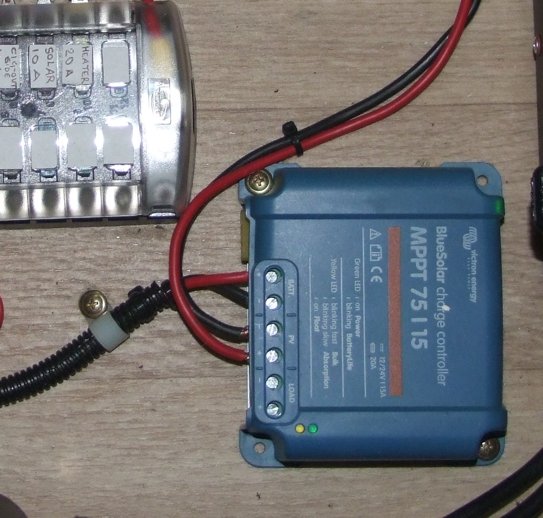
As you can see in the pic, my controller has solar in and battery out, only connected. However, my controller does not have a digital readout, but does have load terminals. There is a digital control that plugs in to the controller (optional extra), I chose a different monitoring method.
The electrical engineer (supplier) I bought the controller from, preset the correct charging profile for the panels I got and the battery type I use. So it was, 2 screws into the floor and 4 wires and ready to go.
However, your digital display, should still allow you to set up the controller with no load to charge the battery. What you will lose by not connecting all loads to the load terminals (consumer or light globe) is the net impact on your battery i.e A in vs A out on the digital display.
It's easy enough to do, all you need is a Red and Black wire to the load terminals of the controller and the other end of them you connect to a fuse block. (at least 6mm sq). The controller should be close to the battery, so the fuse block can be as well. Then whatever is connected to the battery now just goes to the fuse block and in that way you can select the correct fuse for each circuit. Mine is a 12 port Baintech fuse block rated to 30A max individual fuse and 100A total for the block. So get a good one, cheapies can burn out and may not be rated.
PS I didn't have time when I installed all of this to do a couple of things i.e. The original van wiring has a battery switch to isolate all battery IN/OUT. My add ons bypass this switch at the moment, but I'm re wiring so they are all isolated to. Plus I'm rewiring solar controller to battery via the fuse block.

As you can see in the pic, my controller has solar in and battery out, only connected. However, my controller does not have a digital readout, but does have load terminals. There is a digital control that plugs in to the controller (optional extra), I chose a different monitoring method.
The electrical engineer (supplier) I bought the controller from, preset the correct charging profile for the panels I got and the battery type I use. So it was, 2 screws into the floor and 4 wires and ready to go.
However, your digital display, should still allow you to set up the controller with no load to charge the battery. What you will lose by not connecting all loads to the load terminals (consumer or light globe) is the net impact on your battery i.e A in vs A out on the digital display.
It's easy enough to do, all you need is a Red and Black wire to the load terminals of the controller and the other end of them you connect to a fuse block. (at least 6mm sq). The controller should be close to the battery, so the fuse block can be as well. Then whatever is connected to the battery now just goes to the fuse block and in that way you can select the correct fuse for each circuit. Mine is a 12 port Baintech fuse block rated to 30A max individual fuse and 100A total for the block. So get a good one, cheapies can burn out and may not be rated.
PS I didn't have time when I installed all of this to do a couple of things i.e. The original van wiring has a battery switch to isolate all battery IN/OUT. My add ons bypass this switch at the moment, but I'm re wiring so they are all isolated to. Plus I'm rewiring solar controller to battery via the fuse block.
condor22
Mike
The other reason I didn't use the Victron digital option is that I have a 240V charger, that is not connected to the solar system and therefore not included in any SOC calculation. As well as an OEM transformer distribution hub with too many bloody wires that are already fused here.
My Monitor is on the battery NEG - Terminal and every in out NEG - wire goes through it. Although how much I use and how much I charge is of interest for individual loads, the critical value I'm after is SOC at any given time I check via the App on my smart phone. I have the same device on my 4x4 Aux and the same App is used (via menu select from one to the other).
That one piece of info tells me if I need to fire up the genny or not or if I need to turn something off for a while.
My Monitor is on the battery NEG - Terminal and every in out NEG - wire goes through it. Although how much I use and how much I charge is of interest for individual loads, the critical value I'm after is SOC at any given time I check via the App on my smart phone. I have the same device on my 4x4 Aux and the same App is used (via menu select from one to the other).
That one piece of info tells me if I need to fire up the genny or not or if I need to turn something off for a while.
Ok mate, sounds like your right on top of your electrical needs! :Y: I on the other hand, have a lot to learn and a limited budget but that's just the way it is.As I said with what I have been able to glean from these pages and 7.62's great practical knowledge, I am confident that my very much less sophisticated set-up will serve me well and more importantly I have a very much clearer understanding of the basics of my set-up.so THANKS AGAIN MATE !..Regards, Rossco.
yeah, Redfin..I got all that.Still might have to cart a small esky about with me filled with dry ice for the meat ] ..but you know, things like butter and ham etc will be ok if I place a thick towel over and around it...and a little ice put in there. ]
..but you know, things like butter and ham etc will be ok if I place a thick towel over and around it...and a little ice put in there. ] ..personally I think it does a little better than what the specs say!...not much but a bit better.They drink their beer warm in Europe!...so warm beer is better than no beer...eh!
..personally I think it does a little better than what the specs say!...not much but a bit better.They drink their beer warm in Europe!...so warm beer is better than no beer...eh! 
 ...thing is I'm liable to be with 7.62 mostly...so I'll drink his beer...it's bound to be way cool in the Turtle! ]
...thing is I'm liable to be with 7.62 mostly...so I'll drink his beer...it's bound to be way cool in the Turtle! ] ]
] ...hehe!....I'll just wait till he's outa site with the Goldmaster 1000...and pilfer it from his fridge!
...hehe!....I'll just wait till he's outa site with the Goldmaster 1000...and pilfer it from his fridge!  ]
] ....he won't know....yeah right!.
....he won't know....yeah right!. 
Thanks for the info though mate.
Thanks for the info though mate.
Don't touch Peltier devices with a 10' pole (or, indeed, an 8' Hungarian) they
are rotten at general purpose cooling or heating and use lots of energy in
order to be rotten. Their area of real use is in specialised cooling or heating
situations (usually industrial) when energy consumption is not important.
Take a look at these:
https://www.techniice.com/dry-ice-packs.html
They gave me some for free when I bought a fridge/freezer from them, I
haven't used them yet but the information supplied with them is impressive.
are rotten at general purpose cooling or heating and use lots of energy in
order to be rotten. Their area of real use is in specialised cooling or heating
situations (usually industrial) when energy consumption is not important.
Take a look at these:
https://www.techniice.com/dry-ice-packs.html
They gave me some for free when I bought a fridge/freezer from them, I
haven't used them yet but the information supplied with them is impressive.
Similar threads
- Replies
- 1
- Views
- 777



